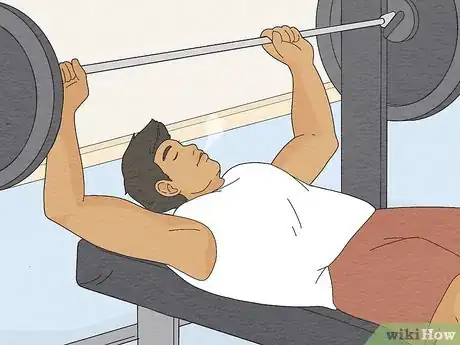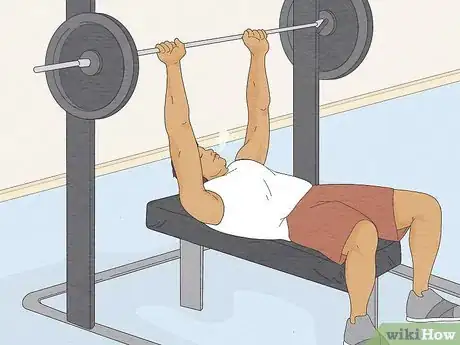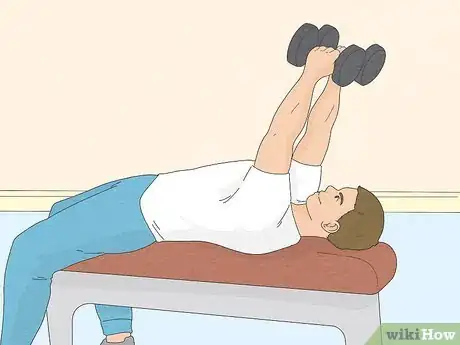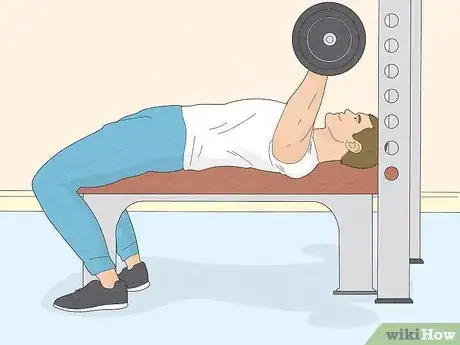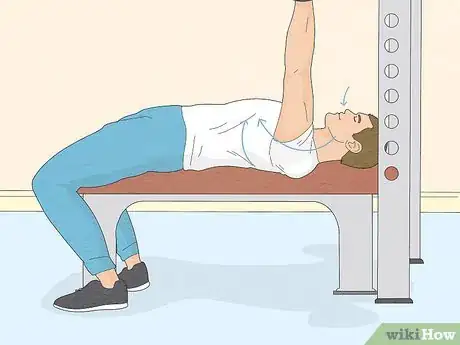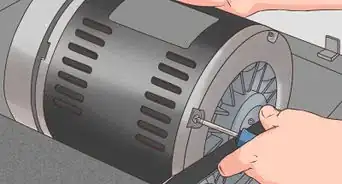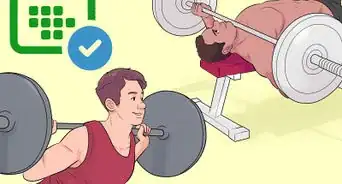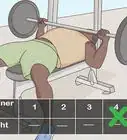This article was co-authored by Katie Prendergast. Katie Prendergast is a Certified Personal Trainer, Nutrition Coach, and the Owner of KPxFitness. With over seven years of coaching experience, she has expertise in helping skiers, snowboarders, and hikers build strength and endurance to enjoy more outdoor adventures. Katie earned her Personal Training Certification and Corrective Exercise Specialist Certification from The National Academy of Sports Medicine (NASM) and is a Pain-Free Performance Specialist (PPSC).
There are 10 references cited in this article, which can be found at the bottom of the page.
This article has been viewed 81,769 times.
Breathing correctly is one of the most overlooked factors while exercising. During the bench press, having the correct breathing technique will create a solid, tight body which can effectively support weight. As a general guideline, you will breathe in before you unrack the bar, hold your breath as you descend, and exhale as you press the weights up. [1]
Steps
Knowing the Basics
-
1Inhale before you begin.[2] After you’ve warmed up, done some deep breathing exercises, and are in proper form, take in your initial breath right before you unrack the bar.[3] Alternatively, you may breathe while your arms are descending, but keep in mind your body might lose its tightness. [4]
- As you breathe, your trunk, which is comprised of your chest, belly, lower back and sides, should inflate like a balloon, expanding outwards. [5] Your chest will expand towards the ceiling.
- Make sure your form is correct. You should be laying flat on the bench, eyes looking straight up at the bar. Your chest should push out and your shoulder-blades should be squeezed together. Your feet should remain flat on the floor.
- There should be a moderate or neutral gap between your hands. Hold the bar with a full grip (in your palms) and straight wrists. If necessary, chalk your hands.
-
2Hold your breath as you lower the bar. As you lower the bar towards your chest, keep holding your breath even as you reach your sticking point. This is the point where the weight feels heaviest and is usually right above your chest.
- As you lower the bar, keep your shoulder-blades squeezed, elbows in and chest up and out.
- While you bring the bar down, your elbows will want to expand to a 90 degree angle. Keep your lats (back muscles) tight and your elbows in, at about a 45-75 degree angle from your body. [6]
- If you take a breath when the weight has reached the bottom, you will loose stability in your torso.
Advertisement -
3Try exhaling gradually if you are a beginner. Right before the bar hits your chest, begin to press up. As you push the bar up, gathering strength from your back muscles, exhale slowly through pursed lips until you’ve reached the top. Keep your throat constricted to maintain some air in your lungs. Once you've reached the top, lock your elbow joints (lockout), and replace the bar on the rack. [7]
- The gradual exhalation will assist and fuel your muscles as they push the weights up.[8]
-
4Breathe out at the end if you are more advanced.[9] If you have more experience, exhale at the top of your press, after you have locked your elbows and move the bar over your shoulders. Some bench-pressers often do multiple reps in the same breath.
Avoiding Common Mistakes
-
1Warm-up before you begin.[10] Warming up is essential to increasing blood flow and your core temperature, allowing for better breathing and stronger form. A simple warm up routine involves deep breathing exercises and doing practice reps with lighter weights.
- For a more complicated warm up, try ramp-up sets, which involves increasing your weight load as you decrease your repetitions. [11] This will best prepare your muscles to bench-press your goal weight.
-
2Keep your form throughout. As you breathe, and throughout the exercise, your shoulders and elbows will likely want to drift upwards and outwards. Remember, keep your eyes on the ceiling, your shoulder-blades tight, and elbows tucked in. Your feet should remain grounded on the floor.
- Your shoulders might want to lift as if you were breathing while standing up. It is important that they stay tight and pressed to the seat. By keeping your shoulder-blades tucked in, your shoulders will remain stable.
-
3
-
4Don't forget to breathe. Many skilled bench-pressers do many reps in the same breath. If you are a beginner, don't force yourself to do the same. Taking an initial breath will provide the necessary stamina to fuel your press, but it will take careful training to build up your resistance.
Expert Q&A
-
QuestionHow do I increase my bench press?
 Michele DolanMichele Dolan is a BCRPA certified Personal Trainer in British Columbia. She has been a personal trainer and fitness instructor since 2002.
Michele DolanMichele Dolan is a BCRPA certified Personal Trainer in British Columbia. She has been a personal trainer and fitness instructor since 2002.
Certified Fitness Trainer The best and fastest results are gained when you increase your weight in small increments. Add only the smallest amount when increasing. When that becomes manageable, increase again.
The best and fastest results are gained when you increase your weight in small increments. Add only the smallest amount when increasing. When that becomes manageable, increase again. -
QuestionHow should I breathe when bench pressing?
 Michele DolanMichele Dolan is a BCRPA certified Personal Trainer in British Columbia. She has been a personal trainer and fitness instructor since 2002.
Michele DolanMichele Dolan is a BCRPA certified Personal Trainer in British Columbia. She has been a personal trainer and fitness instructor since 2002.
Certified Fitness Trainer Exhale on exertion, which is the pushing phase. Many lifters will hold their breath until they reach the maximum push distance. Inhale as you lower the bar.
Exhale on exertion, which is the pushing phase. Many lifters will hold their breath until they reach the maximum push distance. Inhale as you lower the bar. -
QuestionHow should you breathe when lifting weights?
 Michele DolanMichele Dolan is a BCRPA certified Personal Trainer in British Columbia. She has been a personal trainer and fitness instructor since 2002.
Michele DolanMichele Dolan is a BCRPA certified Personal Trainer in British Columbia. She has been a personal trainer and fitness instructor since 2002.
Certified Fitness Trainer Exhale on the push, as you move the bar away from your chest, and inhale as you lower the bar.
Exhale on the push, as you move the bar away from your chest, and inhale as you lower the bar.
Warnings
- If you are a beginner or are transitioning to heavier weights, enlist the help of a spotter in addition to having a spotting device.⧼thumbs_response⧽
- As with all high-intensity exercise, stay hydrated.⧼thumbs_response⧽
- It is common among weightlifters to use the Valsava Maneuver, which involves attempting to exhale against closed airways. Some bench-pressers do so in the 3rd phase, as they press up. However, studies have shown that while there are some potential benefits, it does lead to increased blood pressure, and should be avoided if you have a history of cardiovascular problems, glaucoma, or any burst blood-vessels.[14]⧼thumbs_response⧽
References
- ↑ http://www.fitstep.com/2/2-how-to-build-muscle/muscle-tips-tricks-articles/articles/nick-nilsson/how-to-breathe-properly-when-training.htm
- ↑ Katie Prendergast. Certified Personal Trainer & Nutrition Coach. Expert Interview. 21 February 2022.
- ↑ Katie Prendergast. Certified Personal Trainer & Nutrition Coach. Expert Interview. 21 February 2022.
- ↑ https://stronglifts.com/bench-press/#Breathing
- ↑ https://www.t-nation.com/training/you-dont-know-how-to-breathe
- ↑ https://stronglifts.com/bench-press/#Increasing_Your_Bench_Press
- ↑ https://stronglifts.com/bench-press/
- ↑ https://www.builtlean.com/2013/10/24/bench-press-form/
- ↑ Katie Prendergast. Certified Personal Trainer & Nutrition Coach. Expert Interview. 21 February 2022.
- ↑ Katie Prendergast. Certified Personal Trainer & Nutrition Coach. Expert Interview. 21 February 2022.
- ↑ https://www.t-nation.com/training/most-intelligent-way-to-warm-up
- ↑ Katie Prendergast. Certified Personal Trainer & Nutrition Coach. Expert Interview. 21 February 2022.
- ↑ http://www.coreexercisesolutions.com/belly-breathing/
- ↑ https://breakingmuscle.com/fitness/is-the-valsalva-maneuver-safe-and-effective
